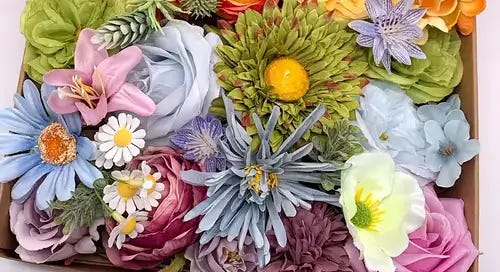Following the Royal Model: On the Occasion of Cutting Imitation Flowers in the Royal Banqueting Hall on the First Day of Spring Shangguan Wan'er A blade sets leafy thickets spilling out, One cut, and a fresh flower bud unfolds. To grasp a branch would be to know the truth, But pick a bloom, and the illusion holds. The spring has always brought a blossoming, Come autumn, they now see no cause to thin. So, all you trees, peach, plum, I ask of you: We can’t tell you from these. What will you do? 上官昭容 奉和圣制立春日侍宴内殿出翦彩花应制 密叶因裁吐,新花逐翦舒。 攀条虽不谬,摘蕊讵知虚。 春至由来发,秋还未肯疏。 借问桃将李,相乱欲何如。 Following the Royal Model: On the Occasion of Cutting Imitation Flowers in the Royal Banqueting Hall on the First Day of Spring Liu Xian The palace in the royal park is good! The light of spring comes early only here. We cut these flowers, yet they seem to bloom, Carved swallows seem to curiously peer. Intensely coloured, flecked with lightest snow, But muted scents that gentle zephyrs blow, I’m honoured to attend my lord this day, And take these sprigs my king chose to bestow. 刘宪 奉和圣制立春日侍宴内殿出剪彩花应制 上林宫馆好,春光独早知。 剪花疑始发,刻燕似新窥。 色浓轻雪点,香浅嫩风吹。 此日叨陪侍,恩荣得数枝。
This last pair of poems from the celebration in 708 represent perhaps the best and worst of them. I love the dumb bluntness of Liu Xian’s first line: the palace is good! His images are minimal, his language simplistic, and he seems mostly concerned with directly addressing the emperor and expressing his thanks.
Shangguan Wan’er, though, makes something slightly new. She uses parallelism in three different ways in her first three couplets, creating a pleasing play of expectation and subversion. Then, at the end she makes a coquettish direct address, personifying the peach and plum. Rather than flatter the emperor, Shangguan, who was a concubine and probably frequent ghost writer for the emperor, shows off her skill. She gives a more accurate description of the imitation flowers than the others: she refuses to use the tired tropes about these flowers fooling birds and insects, and avoids the vexed issue of whether they have fragrance or not. And she ends with the innovative personification.
Shangguan (664-710) was one of the most influential literary figures of her time. As a court writer in her own right, and as a ghost writer, she had shaped elite writing for decades. There are stories of her judging court poetry contests. She worked within the court poetry style, but her innovations helped lay the foundations for the high Tang - the great explosion of new voices that would follow in the 8th century.
Before I leave this series of poems, I want to point out a couple of final things that might not be obvious. Firstly, the social nature of the poems seems very clear. As well as responding to the theme, which was probably set by the emperor (or maybe Shangguan on the emperor’s behalf), the poems seem to be in conversation with each other.
Su Ting claims that there’s a rich perfume, and Song Zhiwen claims the flowers are scented, but Zhao Yanzhao says the scent is subtle, and Liu Xian calls it muted. In the room, as they read or sang these poems, it feels like these rebuttals would be recognised, and appreciated. Even more directly, Zhao Yanzhao says that if you pulled down a branch of the imitation flowers, they would still seem real. Shangguan gently disagrees, suggesting that in reality, the fingers could tell the branches were fake, but the eyes would still be fooled by the flowers. It’s easy to picture the poets putting actions to their words as they did this.
Finally, there is at least a potentially erotic element here. One of the traditions on the First Day of Spring was for women to put the silk flowers in their hair. If the female attendants or dancing girls did so, then this would introduce a whole new layer of meaning to the lines about the fragrance of the flowers, and to the trees that the flowers appear on.



